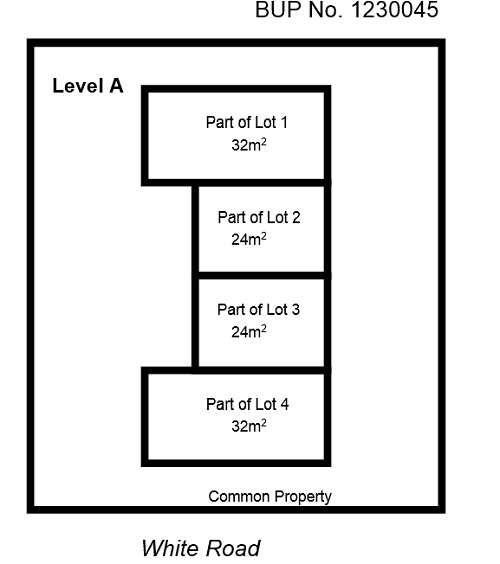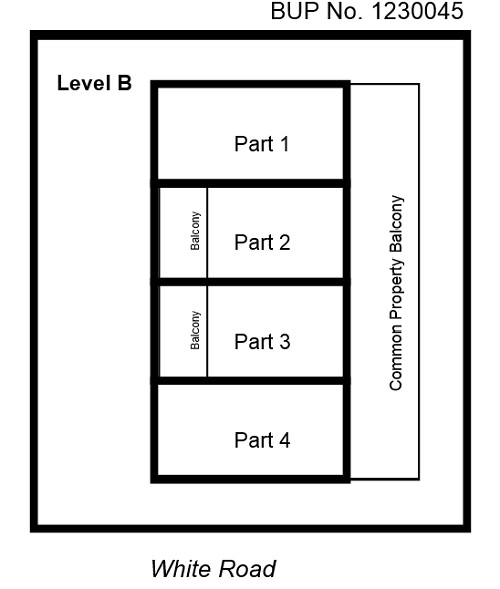Building format plan and building units plan maintenance
A building format plan (BFP), also known as a building units plan (BUP), is a form of subdivision which usually applies to multi-story unit complexes. This plan type can also apply to any other developments like townhouses, villas, housing estates or duplexes.
This information applies to:
- subsidiary bodies corporate under the Building Units and Group Titles Act 1980 (BUGT Act)
- community titles schemes under the Body Corporate and Community Management Act 1997 (BCCM Act).
Who is responsible
To work out who is responsible for maintaining something, find out which plan of subdivision your development is registered under. This can be a:
or
- ‘building format plan’ or ‘building units plan’.
You can find this information on your body corporate’s ‘survey plans’. Contact Titles Queensland to find your survey plans.
Defining lots and common property
The Land Title Act 1994 defines a BFP (or BUP). Where 1 lot is separated from another lot or common property by a floor, wall or ceiling, the boundary of the lot is the centre of the floor, wall or ceiling.
This diagram represents a typical 2-storey building format plan. It shows how common property and lots may be drawn on a plan.
On a BFP or BUP, the boundaries of a lot are represented by hard black lines. The diagram of level A shows the common property surrounding the building and parts of the 4 lots (units).
Plans can also show visitor parking spaces, carports or other features like swimming pools. This common property and the lots together make up the scheme land.
The diagram of level B shows the rest of the 4 lots and a common property balcony running along the eastern (right) side of the building.
The thin line around this balcony shows that it is outside the boundaries of the lots, so the balcony is on common property.
Compare this to the hard black lines around the smaller balconies on the western (left side) of lots 2 and 3. This shows that these balconies are within the boundaries of lots 2 and 3.
Where a balcony is included in a lot (as in lots 2 and 3 of level B) the boundary of the lot is the face of the balcony.
Body corporate maintenance
The body corporate must maintain common property, as well as some things that are not on common property.
BCCM Act responsibilities
A body corporate under the BCCM Act is usually responsible for maintaining:
- the outside of the building
- the foundations and roof of the building
- roofing membranes that are not on common property but give protection for lots or common property
- essential structural elements of the building (like foundation structures, roofing structures that provide protection and load-bearing walls) even if they are not on common property
- roads, gardens and lawns on common property
- facilities on common property (like swimming pools and barbecues)
- railings or balustrades on, or near to, the boundary between a lot and common property, including the balustrade on a private balcony
- any doors or windows, and their fittings in a boundary wall between a lot and the common property (including garage doors and their fittings)
- utility infrastructure (like equipment, pipes and wiring) that is on common property, or in a boundary structure, or services more than 1 lot.
BUGT Act responsibilities
A body corporate under the BUGT Act is usually responsible for maintaining:
- the outside of the building
- roads, gardens and lawns on common property
- facilities on common property (like swimming pools and barbecues)
- any doors or windows in a boundary wall between a lot and the common property (including garage doors and their fittings)
- fixtures or fittings (including pipes, poles, wires, cables or ducts) that are on common property, or in a boundary structure, or that service more than 1 lot.
There are also statutory easements which can make the body corporate responsible for other things, like:
- ensuring lots have lateral and sub-adjacent support
- ensuring lots have shelter.
Read more about statutory easements in the BUGT Act.
Lot owner maintenance
The lot owner is generally responsible for:
- the inside of the lot, including all fixtures and fittings inside the lot
- doors and windows leading onto a balcony that forms part of the lot
- a shower tray used by the lot, even if it is not within the boundaries of the lot
- utility infrastructure (like equipment, pipes and wiring) that is within the boundaries of the lot and only services that lot
- utility infrastructure (including equipment and associated wiring and pipes) that is on common property, if it only services that lot and is a hot water system, washing machine, clothes dryer, solar panels, air-conditioning systems, television antennae or similar equipment
- any fixtures or fittings, including on common property, that were installed by the occupier of a lot for their benefit
- exclusive use areas the owner has the benefit of, unless the exclusive use by-law says otherwise.
For more information see:
Fire safety and maintenance
Bodies corporate are generally considered occupiers under the Fire Services Act 1990 for fire safety purposes.
This means that if you’re in a body corporate, you have an obligation to:
- maintain fire safety equipment in body corporate buildings, such as
- exit lights
- hydrant boosters
- sprinkler systems
- ensure any people in the building are safe in the event of a fire.
See the Queensland Fire Department’s Building owners and occupiers page for more information.
Paying for maintenance
The body corporate must consider its spending limits and budgets if it needs to spend money on maintenance and to fix defects.
The body corporate cannot pay for, or levy owners for, maintenance that a lot owner is responsible for (e.g. cleaning windows within a lot), unless it:
- has an agreement with an owner
and
- charges that owner for the cost of the work.
BCCM Act
A body corporate under the BCCM Act can carry out maintenance and recover the ‘reasonable cost’ from the lot owner if the owner has not done maintenance required under:
- body corporate legislation
- a notice given under other legislation
- the community management statement, including the by-laws
- an adjudicator’s order
- the order of a court or tribunal.
BUGT Act
A body corporate under the BUGT Act may carry out maintenance and recover the cost from the lot owner if the owner has not done maintenance required under:
- a notice served on the owner by a public authority or local government
- an obligation in an exclusive use by-law
- a referee’s order.
Building format plan webinar
Find out more about maintenance responsibilities in community titles schemes registered under a building format plan of subdivision under the BCCM Act.




